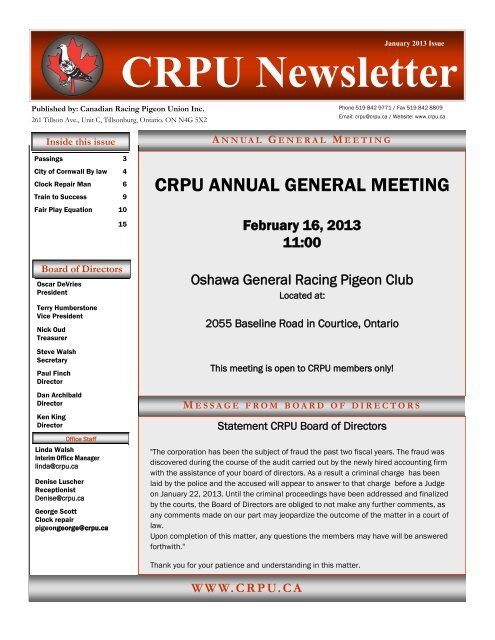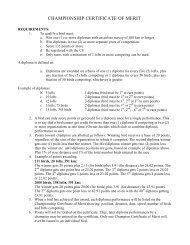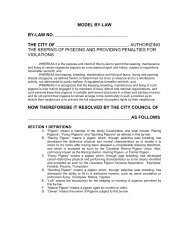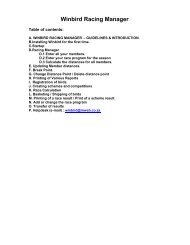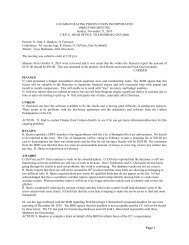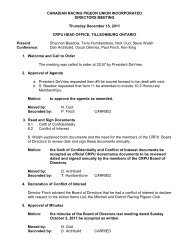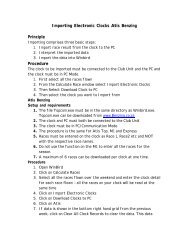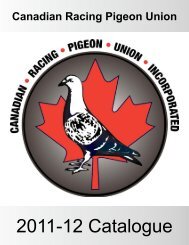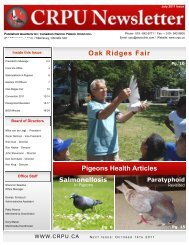January 2013 Newsletter - Canadian Racing Pigeon Union
January 2013 Newsletter - Canadian Racing Pigeon Union
January 2013 Newsletter - Canadian Racing Pigeon Union
You also want an ePaper? Increase the reach of your titles
YUMPU automatically turns print PDFs into web optimized ePapers that Google loves.
<strong>January</strong> <strong>2013</strong> Issue<br />
CRPU <strong>Newsletter</strong><br />
Published by: <strong>Canadian</strong> <strong>Racing</strong> <strong>Pigeon</strong> <strong>Union</strong> Inc.<br />
261 Tillson Ave., Unit C, Tillsonburg, Ontario. ON N4G 5X2<br />
Inside this issue<br />
Phone 519 842 9771 / Fax 519 842 8809<br />
A N N UA L G E N E R A L M E E T I N G<br />
Email: crpu@crpu.ca / Website: www.crpu.ca<br />
Passings 3<br />
City of Cornwall By law 4<br />
Clock Repair Man 6<br />
Train to Success 9<br />
Fair Play Equation 10<br />
Board of Directors<br />
Oscar DeVries<br />
President<br />
Terry Humberstone<br />
Vice President<br />
Nick Oud<br />
Treasurer<br />
Steve Walsh<br />
Secretary<br />
Paul Finch<br />
Director<br />
Dan Archibald<br />
Director<br />
Ken King<br />
Director<br />
Office Staff<br />
Linda Walsh<br />
Interim Office Manager<br />
linda@crpu.ca<br />
Denise Luscher<br />
Receptionist<br />
Denise@crpu.ca<br />
George Scott<br />
Clock repair<br />
pigeongeorge@crpu.ca<br />
15<br />
CRPU ANNUAL GENERAL MEETING<br />
February 16, <strong>2013</strong><br />
11:00<br />
Oshawa General <strong>Racing</strong> <strong>Pigeon</strong> Club<br />
Located at:<br />
2055 Baseline Road in Courtice, Ontario<br />
This meeting is open to CRPU members only!<br />
M E S S A G E F R O M B O A R D OF D I R E C T O R S<br />
Statement CRPU Board of Directors<br />
"The corporation has been the subject of fraud the past two fiscal years. The fraud was<br />
discovered during the course of the audit carried out by the newly hired accounting firm<br />
with the assistance of your board of directors. As a result a criminal charge has been<br />
laid by the police and the accused will appear to answer to that charge before a Judge<br />
on <strong>January</strong> 22, <strong>2013</strong>. Until the criminal proceedings have been addressed and finalized<br />
by the courts, the Board of Directors are obliged to not make any further comments, as<br />
any comments made on our part may jeopardize the outcome of the matter in a court of<br />
law.<br />
Upon completion of this matter, any questions the members may have will be answered<br />
forthwith."<br />
Thank you for your patience and understanding in this matter.<br />
W W W. C R P U. C A
Page 3<br />
CRPU <strong>Newsletter</strong><br />
N OW AVA I L A B L E F R O M T H E C R P U S T O R E<br />
Beyers Enzymix mixtures<br />
With the Elite Enzymix mixes, Beyers offers a unique range of mixes where enzymes have been added.<br />
These enzymes are 100% natural and completely tasteless and odourless.<br />
The enzymes are activated after ingestion of the food, as a result of the conditions in the crop. They ensure<br />
that the cell walls of the grains are broken down quickly. Consequently the pigeons absorb the nutrients<br />
faster and more effectively.<br />
The result is threefold:<br />
• The pigeon gets noticeably more energy from the food;<br />
• The improved digestion results in visibly reduced and drier droppings<br />
• The digestibility of proteins and crude fibres is significantly higher than with traditional mixtures.<br />
What are ENZYMES<br />
However, pigeons don’t produce enzymes which can break down the cell walls of grains and legumes.<br />
These specific enzymes are added to the Elite Enzymix mixtures and ensure the digestion process<br />
happens much more smoothly. Digestion enzymes are therefore “the teeth of digestion”.<br />
Beyers Elite Enzymix is 100% natural. The enzymes are tasteless and odourless<br />
The enzymes won’t be activated until after the food has been ingested<br />
Beyers Elite Enzymix can be given to pigeons of all ages<br />
Within the Enzymix range, we can differentiate between basic mixtures and premium mixtures, of course, always with the<br />
added enzymes.<br />
The premium mixtures within the Enzymix range are recognisable by the addition of Modern System.
CRPU <strong>Newsletter</strong> Page 4<br />
C I T Y OF C O R N W A L L B Y - L A W I S S U E<br />
By Mike van der Jagt<br />
On 14 AUG 2012 I was sent an article from the Cornwall Standard Freeholder reporting that the Cornwall<br />
City Council had voted to prohibit the keeping of pigeons within their municipality. According to the article,<br />
it appeared that this decision was based on inaccurate information with little or no consultation of the<br />
stakeholders affected.<br />
Acting in my role as a member of the CU Municipal By-law liaison committee, I contacted the Cornwall<br />
City Clerk’s office and emailed our concerns and a significant amount of educational material to each<br />
councillor and the Mayor. I followed up the emails by having the CU office staff mail hard copies to everyone<br />
as well.<br />
I also included the Manager of Legislative Services, the Manager of By-law enforcement and the Manager<br />
of Zoning in the distribution.<br />
Along with the letter outlining our concerns with the new By-law, I included detailed biographies of several<br />
pigeon war heroes, a copy of the current CPFA newsletter and CD (with the help of the CPFA executive),<br />
a Veterinary Position Statement Regarding the Health Aspects of <strong>Pigeon</strong> Keeping, a sample By-law<br />
enacted in 2012 by the Municipality of Ajax, a sample By-law enacted in 2012 by the City of Hamilton, Ontario,<br />
a memo from the Chief Medical Officer of Health, a copy of the CU membership application form, and<br />
a copy of the AU publication, Perceptions vs. Reality.<br />
After this preliminary leg work and many follow-up phone conversations and emails, I applied to the City<br />
Clerk to make a deputation before council. I was given this opportunity on 13 NOV 2012. A deputation<br />
allows the speaker 10 minutes to make a case for action to council. Normally five minutes are allowed to<br />
make the presentation and 5 minutes are allowed for questions. Approximately 30 local fanciers and<br />
their friends and supporter attended the meeting. Deputations are generally the last order of business,<br />
but because of the large turn-out, which filled the council chambers to overflowing, they voted to hear the<br />
deputations as the first order of business.<br />
I made the presentation based on the outline found at the end of this article, which took most of the 10<br />
minutes. Sending the background materials ahead of time paid big dividends, because each councillor<br />
was very well informed of the issues, and every one of them followed my presentation with lengthy and<br />
insightful comments. The 10 minutes allocated quickly turned into 45 minutes. In the end, Mayor Bob<br />
Kilger presented council with two options, vote to send the By-law back to staff for review, or leave the<br />
By-law as is. To force the By-law back to staff for further review required a 50% plus one majority vote.<br />
Subsequent changes to the By-law would require a 75% majority. Council voted 6 to 4 to send the Bylaw<br />
back for further review.<br />
Subsequent to this meeting I have been contacted by staff of the City of Cornwall for assistance in drafting<br />
a more workable pigeon control By-law. Also, the issue was returned to council in early December<br />
where staff requested additional time to complete their comprehensive report and recommendations,<br />
which was granted, this time by a 9-1 vote.<br />
Thanks to the efforts of the CU, the CPFA, the local fanciers and the willingness of the City Council<br />
members and staff to study and consider all the new information presented to them, it appears that we<br />
are well on our way to a satisfactory resolution to the initial absolute prohibition of our hobby for Cornwall<br />
residents.<br />
(Continued on page 5)
CRPU <strong>Newsletter</strong> Page 5<br />
C I T Y OF C O R N W A L L BY- L A W I S S U E<br />
(Continued from page 4)<br />
Outline of Presentation to City of Cornwall Council Meeting 13 NOV 2012<br />
On Behalf of<br />
<strong>Canadian</strong> <strong>Racing</strong> <strong>Pigeon</strong> <strong>Union</strong>, <strong>Canadian</strong> <strong>Pigeon</strong> Fanciers Association, Golden Triangle RPC and the Centennial<br />
Homing RPC<br />
Presenter: Mike van der Jagt – Past President <strong>Canadian</strong> <strong>Racing</strong> <strong>Pigeon</strong> <strong>Union</strong><br />
Background and Governance Structure of the Hobby<br />
<strong>Pigeon</strong> keeping and domesticated “doves” pre-date the bible. The modern sport of racing pigeons was developed<br />
in the industrial and mining towns of England and Belgium in the 1800’s.<br />
In Canada, the sport is regulated by the federally chartered <strong>Canadian</strong> <strong>Racing</strong> <strong>Pigeon</strong> <strong>Union</strong> (CU), established<br />
in 1929 at the first Annual General Meeting (AGM) held in Toronto Ontario. There are currently 100 CU affiliated<br />
clubs across Canada and 1200 CU members, of which 7 live within the boundaries of the City of Cornwall.<br />
The <strong>Canadian</strong> <strong>Pigeon</strong> Fanciers Association (CPFA) was established in 1902 and regulates the showing of the<br />
many hundreds of breeds of fancy or exhibition pigeons such as Fantails, Pouters and Dragoons. It currently<br />
lists 31 affiliated clubs with approximately 700 members across Canada.<br />
Both the CU and the CPFA are run by a volunteer board of directors, voted in at their respective AGM’s. Both<br />
are not for profit organizations with a mandate to promote the hobby of pigeon keeping across Canada.<br />
The CU in turn is regulated by the Federation Colombophile Internationale (FCI) which sets the standards of<br />
care and competition for racing pigeons worldwide.<br />
All racing pigeon fanciers in Cornwall are affiliated with one of two CU clubs, the Golden Triangle <strong>Racing</strong> <strong>Pigeon</strong><br />
Club or the Centennial <strong>Racing</strong> <strong>Pigeon</strong> Club and are members in good standing of the CU.<br />
Wild <strong>Pigeon</strong>s verses Domestic <strong>Pigeon</strong>s<br />
Wild city pigeons are exotic invaders from Europe that originated from the early explorers that brought them<br />
as a meat source. Domestic pigeons have been selectively bred for 5000 years and bear little in common<br />
with their wild cousins. Domestic pigeons have a very low survival rate in the wild and do nothing to contribute<br />
to the populations of wild pigeons roosting on ledges in downtown cities. Banning domestic pigeons as a<br />
control measure for wild pigeons would be similar to banning dogs to control the coyote population.<br />
Impact of the By-law<br />
<strong>Pigeon</strong> keeping is a 365 day a year activity. To be competitive in the weekly races or shows, members must<br />
have their birds under rigid control, and in a state of peak health and fitness. Members invest a lot of money<br />
in obtaining pure bred bloodlines, health supplements, housing and training their birds. It requires considerable<br />
dedication, often involving the whole family, to produce race or show winners.<br />
(Continued on page 6)
Page 6<br />
CRPU <strong>Newsletter</strong><br />
C I T Y OF C O R N W A L L BY- L A W I S S U E<br />
(Continued from page 5)<br />
The result of this significant investment in time, energy and money is that most fanciers develop a strong attachment<br />
to the hobby and their birds. They spend the majority of their spare time working with the birds in<br />
their own backyard, traveling to other towns for competitions and travelling internationally to conventions and<br />
major meets. In other words, it is more than a hobby, it is a life style.<br />
The affect of the recent registered letters send out by the City ordering Cornwall pigeon keepers to dispose of<br />
their life’s work (in some cases 3 rd and even 4 th generation) has been unsettling to say the least. These letters<br />
have turned their lives upside down, without even a chance to explain their hobby.<br />
The CU, CPFA and the local pigeon keepers of Cornwall feel that the new By-law should be given a second<br />
look by council. They feel this is a reasonable requested based on the facts that:<br />
· This By-law appears to have been passed as a reaction to a single complaint;<br />
· Media reports claim that the By-law was passed based on the mistaken belief that pigeons are a significant<br />
health concern to humans;<br />
· There appeared to be little consultation of any affected stakeholder prior to the By-law being passed;<br />
· Council overruled the recommendations of staff that pigeon keeping be allowed under certain regulations;<br />
and<br />
· The By-law offers no grandfathering rights.<br />
Benefits of a More Balanced Approach<br />
All the stakeholders represented by this presentation recognize and support council’s right and need to regulate<br />
an activity that could have a negative consequence on other residents.<br />
The CU has considerable experience and willingness to work with City staff to draft a revised By-law that allows<br />
the responsible ownership of pigeons while at the same time protecting all the rights of non-pigeon keepers.<br />
This creates a win/win situation where the needs of all residents can be met.<br />
The CU has been successful in achieving this goal with various other Ontario municipalities including Toronto,<br />
Brampton, Ajax, Innisfil, Markham, Hamilton and others.<br />
Membership in either the CU for racing enthusiasts or the CPFA for exhibition fanciers ensures that all municipal<br />
regulations will be followed. The hobby is self policed, removing this burden from local By-law enforcement<br />
officers.<br />
What We are Asking of Council to Consider<br />
· Please postpone from sending any more registered letters to residents on this issue.<br />
· Please rescind the letters already sent.<br />
· Please allow the CU to work with City staff to draft a replacement By-law that will address all the concerns<br />
of council and also allow responsible pigeon ownership through regulation, not prohibition.
CRPU <strong>Newsletter</strong> Page 7<br />
T R I A L S A N D T R I B U L A T I O N S OF O U R C L O C K R E PA I R MAN<br />
Hello, my name is George Scott and I was asked to be the CRPU Unikon service<br />
and repair man, by my friend Steve Walsh back in March 2012.<br />
I had been servicing the Unikon clocks for a month or so and things were going well<br />
with several clocks coming in. About a month or so later I get a call from a club race<br />
secretary in B.C. I believe, she was trying to chip 2012 young birds as they fly these<br />
young later off the old bird trailer. She was getting an error and would not allow the<br />
entry of 2012 to register the birds for chipping in the administrator program. I called<br />
David at Deister in the U.S., and this was the first I learned of the new updates,<br />
which he forwarded to me by email.<br />
These updates were posted on the CRPU website as well as emailed to all club<br />
contacts. This was very short notice for club race secretaries and became quite a problem for most involved. I<br />
did a posting on the CRPU web advising all clubs to get the updates done before going into old birds and not<br />
to leave it till young bird. Well guess what, I was still doing updates over the phone on first basketing day.<br />
My club also uses Unikon system and I am pretty much had to learn as I go, so this was quite a trying experience<br />
that I hope never happens again, LOL. Because, of the time difference across Canada and hours of<br />
work it was necessary to do several of these updates from home, usually taking 2 hours or better by phone.<br />
A few club race secretaries just gave up and made the two hour or better drive to Tillsonburg for me to do for<br />
them. Many club secretaries were assisted by a sister, wife, or just a friend, but I believe we all made it into<br />
the race season.<br />
Now we are into May and first basketing night of old birds with everything running smooth, wrong LOL. Bev<br />
and I just pulled into Steve’s to pick him up on way to club when I received a call, it was Walt from a club in<br />
our combine and their clock would not allow them to basket.<br />
This club runs the Benzing system and our club runs both so I offered to basket for them if they wanted to<br />
make the extra drive. Walt talked it over with the members and not enough still had the conventional type<br />
clocks to basket, thanked me for the offer but would just have to make it a trainer.<br />
Monday morning Walt called me at the CRPU and said club unit kept giving him an error message, this got<br />
me to thinking and told him I wanted to check something and call him back shortly. I took a club unit off the<br />
shelf and just happened to have a friend’s Benzing Express on site as I had chipped a couple of birds for him.<br />
I hooked everything up to basket mode to enter a bird in a race and also got an error message.<br />
I thought for a moment and said to myself no way, could they have done an update as well<br />
With this in mind decided to go into the internal clock and set the date back to 2011, retried a race entry and<br />
bingo. Unbelievable another update taking us by surprise, but this time not finding out in time to get clubs set<br />
up. When I called Walt back he had already talked to Siegel, they had informed him of the update and<br />
emailed it to him. I was still pretty heavy into Unikon battery changes and really not ready to get involved with<br />
this, Walt said he had a young guy working for him good on computers and said they could probably figure it<br />
(Continued on page 11)
CRPU <strong>Newsletter</strong> Page 9<br />
T HE T R A I N TO S U C C E S S P L A T F O R M 3 ( PA R T 2)<br />
Lets continue from where we left of last time, on platform 3 of course.<br />
We talked about the moult, feeding, bathing, vaccinating and feather<br />
lice. While we are busy with the moult it naturally is time to begin about<br />
the upcoming breeding season. Which pigeons are we going to pair together<br />
and from which ones do we want something extra. In principle a<br />
champion breeds out of all of his pigeons because he has confidence in<br />
all of them. If this wasn't the case he wouldn't have them in his loft. The<br />
pigeons which in your judgement are good enough to keep are therefore<br />
good enough to breed out of (otherwise don't keep them). Naturally<br />
there are some exceptions. Sometimes you may have a reasonable to good short distance pigeon that has some<br />
faults in its build but flies well on the short distances due to its will power. You may decide not to breed out of<br />
such a pigeon if you are planning on flying longer distances in the future. Another exception may be (at my<br />
loft) is that I don't breed out of my 5 extreme long distance pigeons, these have eggs from other pigeons under<br />
them, because I don't want more than 5 long distance pigeons. I think only perfect pigeons belong on the<br />
breeding loft, healthy ones of course, they must have scored an 8 for build and should also have flown very<br />
well. If you have a good racer ( I mean a really good one) with a fault, than pair it to one that scored an 81/2<br />
and try to compensate for the fault as well as you can.<br />
At the end of October or sometime in November the champions of the future premate their pigeons, that is they<br />
lock them in their prospective nestbox for a day or two. This allows the partners to get familiar with each<br />
other, which will simplify mating later. Those that have stepped onto the train to success and want to pair early<br />
have already had their birds in their new nestboxes for some time (the week after the last race), that is the<br />
cocks as well as the hens have been moved to their future loft/section. Of course premating can be done twice,<br />
any preparation done now will bear fruit later!<br />
Near the middle of November you will visit a pigeon veterinarian, here in our country we have a number of<br />
very good ones and one of them will surely have time for a visit. If the doctor says all is well than the pigeons<br />
can be paired around the 5th of December. Beginning somewhere near 15/20 November you will begin lengthening<br />
the days and turn on the lights from 7 am in the morning till about 8 pm in the evening (13 hours). The<br />
breeders can have them on from 5 am till 11 pm (18 hours), as we don't race them and therefore it's not a problem<br />
if they begin to moult early.<br />
The pairing date at our loft is around December 5, there can of course be a day or two difference, I still have to<br />
go to work every day. The pigeons have already been premated and in principle the pairing should go<br />
smoothly. During the period that the lights are on (also on during the day) we begin changing from the moulting<br />
mix to a good breeding mix. Now I do have to say that to-day every premium pigeon feed manufacturer<br />
has good quality mixes and you could also use a good race mix or widowhood mix, but if you have a choice<br />
then use a good bag of breeding mix (with ample plant source protein and small seeds). All the couples are<br />
locked up for while, even those that have been paired together for 5 years. One, to prevent cocks from mating<br />
with other hens and second, so that the other pairs are left in peace and not disturbed.<br />
After a few hours, if everything is peaceful in the loft, I begin letting a few pair out, but watch out, only pigeons<br />
that show they are feeling super. I begin with the new pairs, they are let out first, the old pairs can wait<br />
awhile (this is the opposite order of most fanciers). In a three day period I will have had all the pairs loose at<br />
least once or more, after this I let all the pairs loose in the loft. Pay attention, every year there are pigeons that<br />
want to go back to their old partner, don't let those pairs out at the same time. Take a few extra days to let these<br />
(Continued on page 13)
Page 10<br />
CRPU <strong>Newsletter</strong><br />
T HE F A I R P L A Y E Q UA T I O N<br />
By Tom de Munnik<br />
For many years racing homer organizations have tried to even the playing field whereby small lofts can compete<br />
against the numbers flown by the large lofts. Several years ago the system of choice by clubs and combines was clocking<br />
limits, but it was eventually realized that this method actually presented an artificial result.<br />
These days most all clubs and combines are using a shipping limit, based on space on the trailer. The problem with<br />
shipping limits in most part is that they are set too high for the majority of lofts. Race schedules today usually have dual<br />
races over ten to twelve weekends from 60 to over 500+ miles for old birds and similarly for young birds with shorter<br />
distances. Numbers do matter, particularly when it’s a tough season with extensive long races in the program. The<br />
large lofts are generally hard core competitors and ship the limit from start to finish, for them that is how the game is<br />
played.<br />
There are many reasons why the majority of pigeon lofts are small to medium in size and volume ( 12 to 16 pair of o/b<br />
racers) and (30 youngsters ) It may be financial resources, location, family responsibility, job, neighbors, by-laws, etc,<br />
etc. In most cases the racing pigeon sport has to function in harmony with ones life style and responsibilities.<br />
There are also good reasons why so many clubs have splinter groups break away from the large shippers or even worse<br />
quit all together. We generally get enough new flyers annually to generate moderate growth in the sport, the problem<br />
is that we can’t hang on to the ones we have. Do the math in your own club for the past 20 years and see how many<br />
have left the sport. You will be amazed at the number. In most cases it was not a pleasant or competitive experience<br />
for them. Most small lofts run out of birds near the end of the season and the number issue compounds to the point<br />
that the competition is over for them.<br />
The above is not meant to bash large shippers. They have made sacrifices, plans and resources available to satisfy their<br />
need for fierce competition and their best chance to win. They do create a challenge for others, which is what keeps<br />
those lofts in the game. I think the issue is when the spread is too great for the majority to compete for what is offered.<br />
This is especially so with open shipping, where there are lofts shipping double or triple the birds against most others.<br />
All sports are tweaked to keep the game competitive in the overall picture. They do it in football, hockey, etc., etc.<br />
The easiest solution is a shipping limit but it should not be tailored to trailer capacity, unless space is an issue. If you<br />
find the need to keep a competitive environment for the majority in your combine, then a decision should be made. It<br />
might serve the sport to set a limit based on the mean average of the total birds shipped divided by the number of<br />
races and then divided by the number of lofts to get to your ship limit.<br />
Total birds shipped<br />
(---------------------- ) Divided by ( Total lofts ) = shipping limit<br />
number of races<br />
(Continued on page 12)<br />
W W W. C R P U. C A
CRPU <strong>Newsletter</strong> Page 11<br />
T R I A L S A N D T R I B U L A T I O N S OF O U R C L O C K R E PA I R MAN<br />
(Continued from page 7)<br />
out. He informed me day or so later he and Matt had figured it out and done a couple clocks, all would be<br />
ready for the next basketing night. I was thankful not to have to get involved with Benzing at this time, wrong<br />
again.<br />
An hour or so later I got a call from another club that ships in a different combine, they also use Benzing and<br />
experienced the same problem. I suggested for now they contact Walt as he already had the update figured<br />
out and he would probably be able to help them. Walt sent the update but they had no one ready to tackle this<br />
and decided to send all members’ clocks to Siegel in US for updates, the price sounded quite reasonable.<br />
Week or so later I get a call saying these were 3 Australian versions that Siegel could not do the update on<br />
and I was asked if I could help them out. I called Walt and he was just boxing up 2 to send to Siegel as well<br />
that they were unable to update them. I asked if they were an Australian version and he said yes, told him not<br />
to bother and explained 3 were on their way back not updated.<br />
I asked at the office if we had a contact for Benzing and was introduced to Hanno via email. Hanno asked<br />
what I needed and he would help me out, a short time later I received an email from the support team for all<br />
versions of the Benzing clocks. Now to figure this out, took several hours to do the first one and 5 minutes for<br />
the rest. LOL. Like I said earlier, I am pretty much learning as I go but usually am able to figure most things<br />
out. I believe I have established a good rapport with both Unikon and Benzing and hope to never let myself,<br />
the membership, or CRPU get into this predicament again. I already have the newest update for the older<br />
style Benzing Atis and Express due for <strong>January</strong> 1 st 2015. I just want to get a few answers from Benzing before<br />
I release them. I realize this got little lengthy, but wanted club members to know and appreciate what<br />
their race secretaries have to do in order to get ready for the race season. If you have a problem with your<br />
clock or software the best way to contact me is by email at pigeongeorge@crpu.c , or call the office and leave<br />
a message. If for some reason I am not able to help you out I will put you in touch with someone who can.<br />
Wishing you all the best of health, and hopefully the odd win in <strong>2013</strong>, George<br />
P A S T P R E S I D E N T P AT D A K I N<br />
We have recently learned that one of the Past Presidents of the CRPU, Pat Dakin<br />
passed away at his residence at the age of 62, last September 22, 2011.<br />
Pat served on the board of Directors as President in 1997, 1998 and 1999.<br />
Thanks Pat for your past service to the sport! Rest in peace.<br />
Our condolences to the family!!!
Page 12<br />
CRPU <strong>Newsletter</strong><br />
T HE F A I R P L A Y E Q UA T I O N<br />
(Continued from page 10)<br />
There is also an equation that can be used where a combine or club has open shipping, no limits of any kind and one<br />
where there are some shipping double or triple to those in the majority. The below is a simple equation added to your<br />
results that can “even the playing field for all” and here is how it works: If you have a standard 100 positions for any of<br />
the awards declining to 1. You then add the equation based on number of birds shipped per loft, you come up with a<br />
fair value result, whereby the number shipped is only relative to the value. You might even wonder why am I shipping<br />
so many. Herewith is the example:<br />
Number shipped<br />
( ---------------- ) + ( race position in declining manner )<br />
1000<br />
A shipped 20 birds and is 1 st = 20/1000 = 50 so 50 + 100 = 150<br />
B shipped 10 birds and is 2 nd = 10/1000 = 100 so 100 + 99 = 199<br />
C shipped 5 birds and is 3 rd = 5/1000 = 200 so 200 + 98 = 298<br />
D shipped 1 bird and is 4 th = 1/1000 = 1000 so1000 + 97 = 1097<br />
A shipped 20 birds and is 5 th = 20/1000 = 50 so 50 + 96 = 146<br />
The results of the above is that A shipping double the birds of B needs to place two in the top five to stay ahead of B<br />
and to stay even with C , this scenario carries right on through all the positions offered. This system is based on an<br />
equal value of your team no matter what its size.<br />
I am not suggesting that the above is the answer but am just trying to draw attention to why are so many leaving the<br />
sport or breaking away in small groups. There are of course other reasons why this might be, but if you get hammered<br />
week after week and you believe it is for the above reasons, then as a majority group you might look at changing the<br />
playing field. Just keep in mind you don’t want to loose the large shippers either. They are the trend setters, nor do you<br />
want to default to the lowest denominator.<br />
The large shippers may or should have the option to ship two or three teams, or you might have a larger limit for the<br />
short distances and a reduced number for the long. They are all options in the negotiating process.<br />
Excess trailer space is not a problem either, matter of fact it is a luxury, more space for the good of the birds or even<br />
more important “team up with another combine” to increase the competition and cut the costs. It’s all about harmony<br />
and co-operation for the good of the sport.<br />
I think I will go in hiding until the dust settles after writing this one.<br />
CRPU ANNUAL GENERAL MEETING<br />
FEBRUARY 16, <strong>2013</strong> 11:00 AM<br />
OSHAWA GERNERAL RAICNG PIGEON CLUBHOUSE<br />
2055 Baseline Road in Courtice, Ontario
CRPU <strong>Newsletter</strong> Page 13<br />
The Train to Success Platform 3 (Part 2)<br />
(Continued from page 9)<br />
pairs get used to each other. If they are stubborn and don't want to pair take one or more of the pigeons of the<br />
loft. You want them to pair the way you planned and you are the boss.<br />
The nest bowls are placed in the nestbox at the same time as the birds are paired, a champion has cleaned them<br />
after the last race and has them clean and dry for the December 5th pairing date. Our couples have a small<br />
breeding box in the corner of their nestbox. By nature pigeons like to breed in cavities, and they think a dark<br />
hole is just perfect. Another advantage is that other pigeons (the neighbour) can't get into it easily, which results<br />
in fewer broken eggs. If you don't have a brood box (there are big enough for the nest bowl to fit inside,<br />
measurements 9x9x9) for every nestbox, then have a shelf so that the nest bowls are up higher, then the unavoidable<br />
battles, when birds get in the wrong box, are more likely to take place away from the nest bowls.<br />
Gert Jan Beute<br />
Translated with permission by Nick Oud<br />
W W W. C R P U. C A


